Transform Your Bathroom with Ceramic Tile Painting


Intro
Transforming a bathroom isn’t just about sprucing up the space with new decor or adding a few fresh towels. One of the most effective and cost-efficient methods to breathe new life into this often-underappreciated room is by painting ceramic tiles.
Often, people overlook the tiles that surround their bathtubs or shower walls because they assume a complete renovation is the only viable option. However, investing time in painting ceramic tile can yield stunning results that dramatically change the ambiance of your bathroom.
This guide serves as a comprehensive resource for homeowners and design enthusiasts, unveiling the intricate details of painting ceramic tile. Besides giving a step-by-step approach, we will also delve into necessary preparations, ideal painting techniques, and tips to maintain that vibrant look.
Why Paint Ceramic Tile?
There are several reasons homeowners might consider painting ceramic tiles. First, it’s a budget-friendly alternative to replacing tiles altogether. Next, it allows for customization of colors and patterns to match your personal style. Painting tiles can also be used to address outdated looks or even conceal imperfections.
While one might feel the urge to leap headfirst into this task, a little planning goes a long way. Let’s explore different design inspirations that can guide you through creative choices.
Prelude to Painting Ceramic Tile
Painting ceramic tiles is not just a home improvement project; it's a means to breathe new life into an often-overlooked space. For many homeowners, the bathroom serves as a personal sanctuary, a place to unwind after a long day. Yet, it can quickly fall into disrepair or simply feel stale and outdated. Herein lies the importance of painting ceramic tiles. This process is not only cost-effective compared to a full renovation but also offers an opportunity to reinvent the look and feel without significant structural changes.
When you consider the benefits, the reasons to paint become clear. It allows for customization that aligns perfectly with personal aesthetic preference, contributing not just to enjoyment of the space but adding to the home's overall value as well. The idea of simply altering the color or finish of existing tiles can feel overwhelming, but with the right preparation and techniques, painting ceramic tiles can transform a dull bathroom into a vibrant, inviting environment.
However, before rolling up your sleeves, it’s crucial to take into account several considerations to ensure lasting results. The article will explore essential elements such as proper cleaning, choosing the right paint, and understanding the intricacies of applying it effectively. Each of these areas plays a significant role in determining the success of your tile-painting endeavor.
With this guide, whether you’re a housewife looking to revamp the family bathroom or a homeowner planning to enhance the resale appeal of your property, you will find comprehensive insights designed to inform and empower you at every stage of the project.
By the end, you'll be equipped not just with practical skills, but with the confidence to turn your bathroom tile from drab to fab.
Preparation for Painting
Preparing to paint ceramic tiles is, without a doubt, a critical phase that lays the foundation for a successful transformation of your bathroom. Skipping this step may lead to chipping, peeling, or uneven application of paint, derailing the entire project. Thus, giving ample attention to preparation ensures not only that the paint adheres effectively but also extends the longevity of the finish.
Assessing the Condition of Tiles
Before rolling up your sleeves, take a good hard look at your ceramic tiles. Are they cracked or chipped? Any stains that seem to be set in stone? Proper assessment allows you to identify what repairs need to be made. This phase is about taking stock; a tile that’s in poor shape will require more attention than a pristine surface. Haphazardly painting over imperfections doesn't just showcase flaws—it can worsen them in the long run.
- Visual Inspection: Check the surface for damages or holes. If you find any cracks or chips, they need repair before diving into painting.
- Surface Integrity: Press on the tiles; they should feel solid underfoot. If they feel loose, it might indicate deeper issues.
- Moisture Check: Leaks can sometimes go unnoticed. Ensure to address any signs of water damage since moisture can undermine the paint job.
Cleaning and Repairing Tiles
Cleaning is next on the agenda, and it’s essential in prepping tiles for paint. Think of it as getting rid of the grime that could compromise your work in a big way. Ideally, start by giving the tiles a wash to eliminate dust, soap scum, or mildew. A simple mixture of water and vinegar works wonders, but don’t shy away from a dedicated tile cleaner for stubborn stains.
When it comes to repairs, patch up any surfaces that may have damage. Use a suitable tile filler for chips, taking care to sand down any rough edges for a level surface. If you're dealing with deeper cracks, you might want to consult a professional depending on the extent of the damage.
- Soaking stubborn stains: For those pesky stains that cling like a bad smell, let your cleaner sit for a while to penetrate the grime.
- Different tools for different jobs: A scrub brush is useful for textured tiles, but a soft cloth works wonders for smoother types.
Gathering Necessary Tools and Materials
Now that the tiles are prepped, it’s time to arm yourself with the right tools and materials. This step can make or break the quality of your paint job. Here’s what you’ll need:
- Paint types: Make sure you opt for an epoxy-based tile paint. It’s durable and perfect for bathrooms which see a lot of moisture.
- Primer: A high-adhesion primer is crucial for helping the paint stick properly.
- Paint applicators: Choose between rollers and brushes based on the tile texture. For large, flat tiles, using a roller might provide a more even finish, while a brush can finesse edges and corners.
- Safety gear: A mask and gloves are essential. You’re protecting yourself from the fumes and any reactions your skin may have.
- Painter's tape: This will help you maintain clean lines and avoid accidental splashes on surfaces you wish to keep paint-free.
"Preparation is the key to success." - Unknown author
Gather up these supplies before starting the actual painting. Each one holds importance in ensuring a smooth painting process. Investing time and effort in these preparatory stages makes for a foolproof plan as you tackle the exciting part—painting your tiles!
Choosing the Right Paint
Choosing the right paint for ceramic tiles is a crucial step in the whole process of transforming your bathroom. It can determine not just the immediate aesthetic appeal of the space, but also the durability and maintenance needed afterward. With numerous products in the market, understanding the characteristics and suitability of each option can feel overwhelmingly complicated.
Firstly, selecting the appropriate paint affects both the finish and the life expectancy of your newly painted tiles. Not every paint type adheres effectively to ceramic surfaces, and using the wrong kind can lead to peeling or fading, costing time and money. Additionally, the right paint can resist moisture, which is particularly significant in a high-humidity area like a bathroom. This means choosing a paint that can stand up to steam and moisture without compromising its color or integrity.
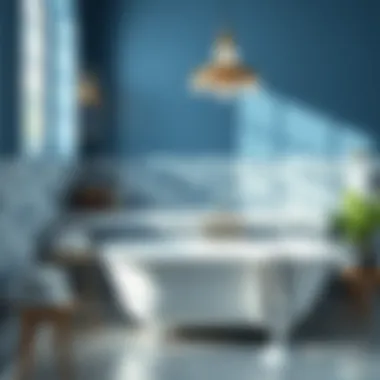
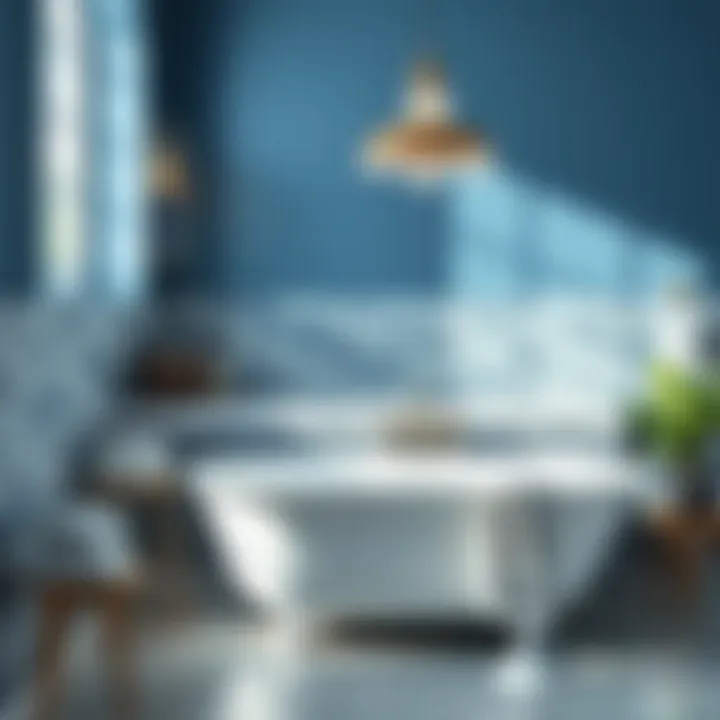
In this section, we delve into specific types of paint, and finish considerations, and help you navigate your choices wisely.
Types of Paint Suitable for Tiles
When it comes to painting tiles, not all paints are created equal. Generally, there are two main types that are deemed appropriate for this task: epoxy paints and urethane-based paints.
- Epoxy Paints: These paints are well-known for their durability and resistance to heavy wear and tear. They are particularly suitable for surfaces that encounter moisture regularly, making them ideal for bathrooms. Moreover, epoxy paints stick excellently to ceramic surfaces, forming a hard, glossy finish that can last for years if applied correctly.
- Urethane-Based Paints: Similarly durable, urethane paints have the benefit of flexibility in application. They can mimic the appearance of traditional tiles while providing a tough protective layer. This type can also come with a variety of finishes, allowing homeowners to select a look that fits their aesthetic preferences.
Choosing between these two types ultimately boils down to your bathroom's specific needs and your design goals.
Understanding Paint Finishes
Once you've selected the type of paint, the next layer to consider is the finish. The finish not only influences the decorative aspect but also has practical effects on maintenance and durability. Common finishes include:
- Matte: While this finish gives a more understated, sophisticated appearance, it might not be the best for tiled surfaces in moisture-rich environments. Stains can become stubborn and challenging to clean.
- Satin: A satin finish offers a compromise, striking a balance between aesthetics and functionality. It's easier to clean than matte finishes but can still show some wear over time.
- Glossy: For tiles in need of an extra layer of shine, a glossy finish reflects light and is generally easier to maintain. It repels dirt effectively but may show imperfections in surface preparation more readily.
Make sure to consider how each finish aligns with your cleaning routine and lifestyle before making a call. Striking this balance is essential.
"Selecting the right paint isn’t just about color; it’s about what will stand the test of time and maintain your vision for the bathroom."
In essence, the paint selection process goes beyond aesthetics; it’s about ensuring a resilient fit for your ceramic tiles and understanding how your choices impact maintenance down the line. Taking the time to evaluate these various aspects will set the groundwork for a successful painting project that breathes life into your bathroom for years to come.
Techniques for Painting Tiles
Painting ceramic tiles in your bathroom can breathe fresh life into an outdated space, but the techniques utilized during this process are paramount to achieving a long-lasting and beautiful finish. Knowing the right techniques can elevate the overall aesthetic appeal and durability of your work. Each method requires careful consideration and proper execution to ensure the tiles not only look good immediately post-application but also stand the test of time against moisture and wear.
Applying Primer
The first crucial step in the painting process is applying a suitable primer. This preparation step is often overlooked but serves as the anchor for your paint. By using a high-quality primer designed specifically for tiles, you create a bond that enhances adhesion and reduces the likelihood of chipping or peeling.
- Why Primer Matters: Primer acts like a shield, ensuring that the paint grips better and providing a uniform surface that allows for a more consistent application. It's like laying the groundwork before building a house—without it, you might find cracks in your investment down the road.
- How to Apply: Lightly sand the tile surface to create texture. This allows the primer to clutch onto the tiles better. Apply the primer using a roller for larger surfaces and a brush for edges, ensuring an even coat. Remember to allow adequate drying time as per the manufacturer’s instructions.
Using a Roller vs. Brush
Choosing between a roller and a brush can feel like picking between apples and oranges; both have their advantages depending on the specifics of the job. Each tool has its unique application style not only affecting the outcome’s look, but also the effort you may have to exert.
- Roller Pros and Cons: A roller can cover large areas efficiently and tends to provide a smoother finish. However, it's not as adept at reaching into the crevices and edges, which can lead to uneven painting along your tile borders.
- Brush Pros and Cons: A brush allows for precision, especially in corners and around fixtures. It may take more time, but it lets you lovingly caress those hard-to-reach spots. For the ultimate finish, some experts recommend a combination approach—using a roller for broad surfaces and a brush for trims and tough angles.
Layering Techniques for Depth
Achieving depth in color and texture can make your painted tiles look remarkable rather than just factory-grade. Here’s where layering comes into play.
- Creating Layers: Start with a base coat, let it dry, and then add a second, contrasting layer to give the tiles that sensational, multi-dimensional feel. For instance, if you start with a light gray, following up with a soft charcoal can create a stunning shadow effect that brings character to otherwise flat surfaces.
- Experiment with Textures: Layering isn’t just about colors; you can also experiment with textures. Applying a matte finish for the first layer and then a semi-gloss or glossy for the top can create an interesting interplay of lights and shadows.
By utilizing the proper primer, selecting the right application tools, and mastering layering techniques, you position yourself to transform your ceramic tiles not just into functional surfaces, but into vibrant artistic expressions that reflect your personal style. Your bathroom can become a showcase of creativity and smart renovations, leading to a space that is not only aesthetically pleasing but also durable and practical.
Post-Painting Considerations
After putting in the time and effort to paint your ceramic tiles, it’s crucial to understand the factors that come into play once the paint is applied. Navigating the post-painting phase is just as vital as the preparation and application steps. This stage requires attention to curing time and best practices to ensure that the finish remains appealing, durable, and easy to maintain over the years.
Curing Time and Best Practices
Curing time refers to the period during which the paint solidifies and bonds completely to the tile surface. This process is essential for longevity and should not be overlooked. Typically, ceramic tiles need about 24 to 48 hours to cure fully, but this crucial waiting period can vary based on factors such as humidity and temperature in your bathroom. During this time, it’s best to keep the area well-ventilated but free of excess moisture.
Here are some best practices to consider:
- Avoid Excessive Moisture: Keep the bathroom dry. If you can, run the exhaust fan to facilitate air circulation but avoid direct drafts.
- Monitor Temperature: Ideal curing occurs in moderate temperatures—preferably between 70°F to 85°F. If it's colder, it may take longer for the paint to set.
- Limit Use of Affected Areas: As tempting as it may be to step back into your refreshed space, keeping off the painted tiles is imperative until they have fully cured. This helps in preventing any scratches or marks that might diminish your hard work.
- Avoid Scrubbing or Cleaning: For the first week post-painting, steer clear of scrubbing the tiles as this might compromise the bond. Light cleaning can be done with a damp cloth.
"Patience is not just a virtue; it's your ally when it comes to painting tiles. Allow them the time they need to set before diving back into normal routines."
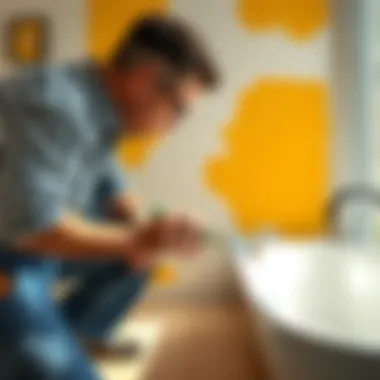
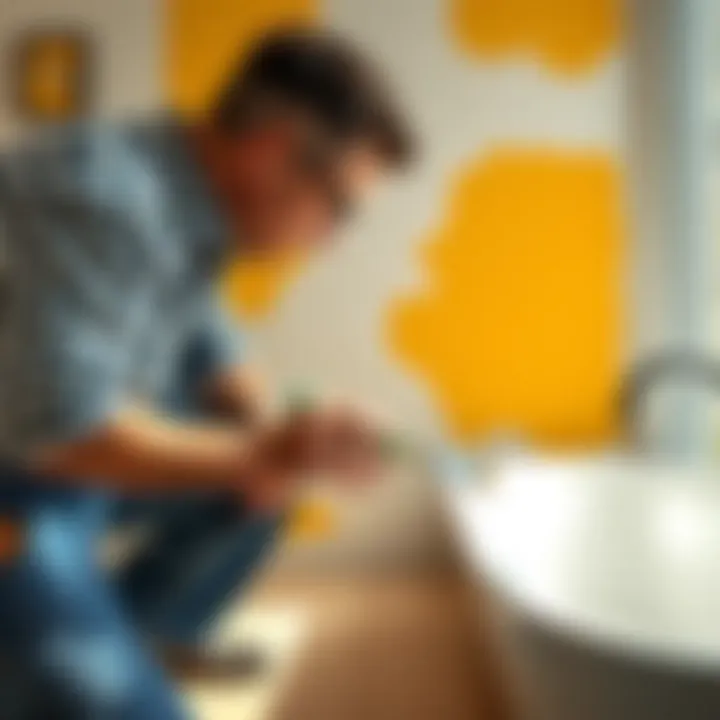
Routine Maintenance of Painted Tiles
Once your tiles have cured, maintaining them becomes the next crucial step to ensure they stay beautiful. Routine maintenance can be straightforward, and a little care goes a long way to extend the life of your newly painted surfaces.
Here are some key maintenance tips:
- Regular Cleaning: Use a mild soap solution and a soft sponge to clean the painted tiles. Avoid abrasive cleaners or scrubbing pads which can damage the paint finish.
- Spot Checking: Keep an eye out for any chips or scratches that may develop. Catching these issues early can save a lot of hassle in the long run.
- Reapplication as Needed: Depending on traffic and wear, you might find spots that need a touch-up. Keep some leftover paint handy for easy repairs.
- Use of Sealants: Many homeowners find that applying a clear sealant after the ceramic tile has cured helps protect the surface from stains and extends the paint’s life. This is an optional step but can be beneficial if you notice frequent issues.
In summary, the post-painting phase is essential for safeguarding your investment. By understanding the curing process and setting in place a solid routine for maintenance, you're not just beautifying your bathroom—you’re ensuring that it remains a well-loved part of your home for years to come.
Design Considerations
When it comes to painting ceramic tiles, the design considerations are the backbone of the entire project. After all, it’s not just about slapping on a coat of paint and calling it a day. Instead, these considerations allow for a harmonious integration of color, texture, and overall style. Look at your bathroom like a canvas; each tile serves as a piece that contributes to the larger artwork in that confined space.
Choosing Color Combinations
Color plays a pivotal role in setting the mood of a bathroom. The right hue can breathe life into a dull environment, while the wrong shade may leave the space feeling off. Start your color journey by visualizing your ideal bathroom ambiance—do you want it to feel serene, cheerful, or perhaps a blend of both?
- Neutral Tones: Whites, beiges, and grays are timeless choices that often evoke calmness. They can make a small bathroom appear larger and brighter. Think of a soft dove gray tile that adds a serene touch against crisp white fixtures.
- Bold Colors: If you prefer a more energetic vibe, deep blues or vibrant greens can make quite a statement. They can create a dramatic contrast with lighter elements in the room. Picture a bright turquoise accent wall paired with light beige tiles; it’s striking yet cohesive.
- Complementary Pairings: Often, the best combinations come from opposite colors on the color wheel. For example, pair rich chocolate brown tiles with soft pistachio green accents. The interplay between the two can create a sophisticated look that keeps the bathroom from feeling too stark or too busy.
Remember: Testing paint colors in different lighting is crucial. What appears lovely in a can often looks vastly different once it's on the tile.
Incorporating Tile Painting into Overall Design
Integrating painted tiles into your overall design layout extends beyond the canvas of the flooring or walls. It’s important to consider how the painted tiles will mesh with existing elements in the bathroom.
- Fixtures and Accessories: Complement painted tiles with matching accessories. For example, if your tiles are painted a deep navy blue, consider brass fixtures for a classic nautical look or brushed nickel for a more contemporary vibe.
- Textiles: Curtains, bath mats, and towels offer additional opportunities for color coordination. If your tiles lean towards the bold side, opt for subtle, muted textiles that won’t compete for attention. On the other hand, with a more neutral tile background, feel free to experiment with vibrant patterns.
- Lighting: Don’t overlook lighting. A well-placed light can enhance the colors in your painted tiles and create varying moods. Consider dimmable LED fixtures that allow for a transition from bright task lighting to softer, ambient hues.
Bringing all these elements together requires a bit of thought and contemplation. Take time to sketch your ideas or use design software for a clearer visualization. The more planning done upfront, the happier you'll be with the results down the line.
Challenges and Solutions
Painting ceramic tile can breathe new life into a tired bathroom, but it's not all smooth sailing. Getting the job done right means being aware of potential challenges. Understanding these hurdles is half the battle. By tackling common issues head-on, you can ensure your painted tiles look attractive and last longer. Awareness helps in making informed decisions, thus transforming challenges into manageable tasks.
Common Issues Encountered
When embarking on this DIY adventure, you may run into a few bumps. Here are some of the typical challenges homeowners face:
- Adhesion Problems: A common headache is the paint not sticking properly to the tile. This usually happens because of inadequate surface preparation. If the surface isn't cleaned thoroughly, or if it hasn't been primed correctly, the paint will likely peel or chip away in no time.
- Color Fading: Over time, exposure to moisture and sunlight can lead to colors that fade faster than a summer tan. Choosing the wrong paint or finish can make your vibrant hue dull after just a few months.
- Uneven Finish: Painting tiles isn't just a slap-dash job. If your techniques aren't up to scratch, you might end up with brush strokes or roller marks, making your lovely tiles look far from perfect.
- Cracking and Chipping: Sometimes, even after a flawless application, you might find cracks or chips appearing a few weeks or months down the road. This can be disheartening, especially after putting in the hard work.
These issues can feel quite discouraging, but don’t toss in the towel just yet! There are effective solutions to each of these problems.
Effective Solutions for Long-Lasting Results
To ensure your painted tiles stand the test of time, consider these tried-and-true solutions:
- Thorough Cleaning and Proper Priming: Start with a deep clean using a mix of vinegar and water to remove any grime or soap scum. After that, use a high-quality primer that’s designed for glossy surfaces to ensure paint adherence. This is a crucial step; don’t skimp on it.
- Selecting the Right Paint: Opt for high-quality, durable paint specifically formulated for ceramics, such as epoxy paint. This type of paint generally offers better adhesion and coverage. Also, look for products that advertise fade resistance to help keep your colors bright.
- Application Techniques: To achieve a smooth finish, use foam rollers instead of brushes for larger surfaces. This helps eliminate visible brush strokes. For detailed areas and edges, a fine-tipped paintbrush can do the trick. Also, don’t rush the job—allow drying time between coats to achieve that professional look.
- Regular Maintenance: Even the best paint job needs upkeep. Use gentle cleaners that won’t harm the paint finish. You might also want to reapply a sealant every couple of years to add an extra layer of protection against moisture and wear.
"Every problem has a solution. You just have to be willing to look for it."
By keeping these solutions in mind, you will turn challenges into stepping stones towards a beautifully transformed bathroom that lasts. This not only enhances the aesthetics but also positively affects the overall value of your home.
Environmental and Health Considerations
When taking on the task of painting ceramic tiles in your bathroom, it's crucial to consider the environmental and health implications of your choices. Many homeowners are now more aware of their ecological footprint and the potential hazards associated with various paints and materials. Not only does selecting the right products play a vital role in protecting the planet, but it also ensures a safe and healthy atmosphere for you and your family.
Sustainable Paint Options
Choosing sustainable paint options significantly impacts both the environment and your indoor air quality. Conventional paints often contain volatile organic compounds (VOCs) that can wreak havoc on the environment and pose health risks. By opting for low-VOC or zero-VOC paints, you not only minimize harmful emissions but also contribute to a healthier living space.
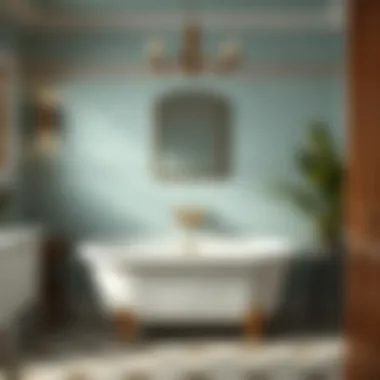
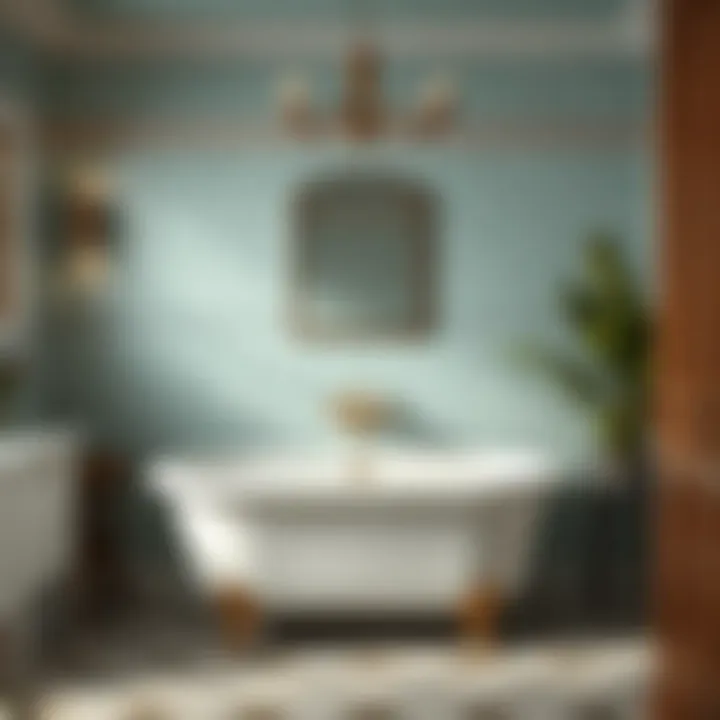
Things to consider when selecting sustainable paint options:
- Look for certifications such as Green Seal or EcoLogo, which indicate adherence to strict environmental standards.
- Choose products made from natural sources, like plant-based paints, which reduce reliance on synthetic materials.
- Research brands known for their commitment to sustainability, like Benjamin Moore or Sherwin-Williams, which offer eco-friendly product lines.
Making conscious choices about the kind of paint you use can go a long way.
Safety Precautions During Application
While painting, safety should be a top priority. Ensuring proper ventilation in your bathroom while you work is non-negotiable. Here are some practical safety precautions to keep in mind:
- Ventilate the space: Open windows and doors or use exhaust fans to circulate air. Good airflow helps disperse any fumes and lowers the risk of inhaling harmful substances.
- Wear protective gear: Utilize masks, gloves, and goggles. Masks can protect against inhaling dust and fumes, gloves keep your skin safe from chemicals, and goggles shield your eyes from splashes.
- Read labels carefully: Be sure to thoroughly read labels for any safety warnings or recommendations. Each product may have different requirements for safe handling and application.
- Keep materials stored safely: When you’re mixing or storing paints, ensure they are kept in a cool, dry place, away from children and pets.
- Dispose of waste responsibly: Follow local regulations for disposing of any leftover paint or materials. Many areas have designated hazardous waste disposal facilities.
By following these guidelines, you create a safe working environment that can reduce risks significantly.
"Painting can breathe new life into your living space, but it's essential to do it while keeping health and sustainability at the forefront."
In summation, paying close attention to environmental and health considerations when painting ceramic tiles is arguably just as important as the aesthetic outcome. With the right approach, you can transform your bathroom into a vibrant space while ensuring it remains safe for all who use it.
Commonly Asked Questionss About Painting Ceramic Tile
When considering the transformation of your bathroom through painting ceramic tiles, having a set of frequently asked questions can be indispensable. This section aims to address common queries that often arise during this project, providing insight into the process and helping to streamline decision-making.
Understanding these frequently asked questions not only aids in addressing potential concerns but also highlights the importance of preparation and the types of materials needed. Homeowners often find themselves in a whirlpool of information, and a focused FAQ section serves as a beacon, guiding them toward clarity.
Frequently Asked Questions
1. Can paint any ceramic tile?
Yes, you can paint most ceramic tiles, but it’s vital to consider the surface's condition. If the tiles are glossy, they will require specific prep work to ensure that the paint adheres properly. Saving time on thorough prep might lead to peeling or chipping later on.
2. What kind of paint should use for ceramic tiles?
It’s best to opt for epoxy or specialized tile paint designed explicitly for ceramic surfaces. Regular paints won’t give you the durability you need in wet areas like bathrooms. Products such as Rust-Oleum Tub and Tile Refinishing Kit have been popular choices among DIY enthusiasts.
3. How do prep my tiles before painting?
- Start with a rigorous cleaning. Use a tile cleaner or a mix of vinegar and water to eliminate grime.
- Repair any cracks or chips with a suitable filler.
- Lightly sand the surface to create a better bonding area for the paint.
Unlike a kitchen where you may be quickly inclined to re-paint because of a change in mood or season, bathrooms require cautious thought due to moisture levels and the need for a durable finish.
4. How long will the painted tiles last?
With the right preparation and high-quality paint, you can expect the finish to last anywhere from 5 to 10 years. Regular maintenance, like gentle cleaning rather than abrasive scrubbing, will significantly extend the life of your painted tiles.
5. Is it safe to use painted tiles in a bathroom?
As long as you use the appropriate paint and follow safety instructions, painted tiles can be perfectly safe and durable for bathroom use. Make sure to choose low VOC (Volatile Organic Compounds) options for a safer air quality post-application.
By addressing these fundamental queries, homeowners can move forward with confidence, armed with the knowledge needed for a successful tile painting project. Carving out time to understand these details leads not just to a cosmetic change but an enhancement of the overall living environment.
Ending: Revitalizing Your Bathroom with Painted Tiles
In many homes, the bathroom is a space that often gets overlooked when it comes to decor and aesthetics. However, with the right techniques and a bit of creativity, painting ceramic tiles can completely transform this essential part of the house. This article has laid the groundwork for understanding the process and the profound impact that painted tiles can have.
Moreover, choosing to paint ceramic tiles is not merely a stylistic choice; it can significantly increase the functionality and ambiance of your bathroom. By refreshing dated tiles, homeowners can create a welcoming atmosphere without incurring the costs of a full renovation. This approach allows for greater versatility in choosing colors and finishes that may align better with personal tastes and contemporary design trends.
Benefits of Painted Tiles
- Cost-Effective Solution: Revamping ceramic tiles through paint is far more economical than replacing them, enabling homeowners to allocate their budgets more efficiently.
- Endless Customization: With the wide spectrum of colors and finishes available, it’s easy to find the perfect match for your bathroom style.
- Eco-Friendly Option: Updating existing tiles instead of discarding them contributes to the sustainability movement, as it reduces waste.
- Easy Maintenance: Newly painted tiles can offer robust protection against moisture and grime, as long as proper care is maintained.
Painting tiles does, however, require careful consideration of the right materials and methods. As discussed, selecting the proper paint type, preparation, and post-paint maintenance are essential for achieving not just a lasting result but also one that enhances the overall bathroom experience.
As a last note, the bathroom is more than just a functional space; it's a personal retreat. By breathing new life into it through painted tiles, you're crafting a sanctuary that reflects your style and meets your needs. This endeavor will not only invigorate your space but also elevate your daily routines, proving that sometimes a simple change can yield the most significant benefits.
Remember: It’s not simply about the paint – it’s about the care and creativity infused into this transformational project. When done correctly, painting ceramic tiles can lead to beautifully rejuvenated bathrooms that inspire peace and comfort.



